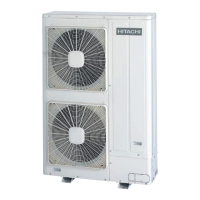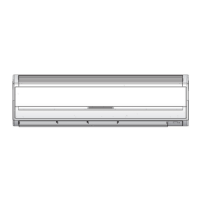27
Table 7.3 Alarm Code
Code Category Content of Abnormality Leading Cause
01 Indoor Unit Activation of Protection Device Activation of Float Switch, High Level in Drain Pan
02 Outdoor Unit Activation of Protection Device
Activation of PSH, Pipe Clogging, Excessive
Refrigerant, Inert Gas Mixing
03 Transmission
Abnormality between Indoor and
Outdoor (or Outdoor and Outdoor)
Incorrect Wiring, Loose Terminals, Disconnect Wire,
Tripping of Fuse
04 Transmission
Abnormality between Inverter PCB and Outdoor PCB
Abnormality between Fan Controller and Outdoor PCB
Transmission Failure (Loose Connector)
05 Supply Phase Abnormality Power Source Phases
Incorrect Power Source, Connection to Reversed-
Phase, Open Phase
06 Voltage Abnormal Inverter Voltage Outdoor Voltage Drop, Insufficient Power Capacity
07 Cycle Decrease in Discharge Gas Superheat
Excessive Refrigerant Charge,
Failure of Thermistor, Incorrect Wiring
08 Cycle Increase in Discharge Gas Temperature
Insufficient Refrigerant Charge, Pipe Clogging,
Failure of Thermistor, Incorrect Wiring
11
Sensor on
Indoor Unit
Inlet Air Thermistor
Incorrect Wiring, Disconnecting Wiring
12
Outlet Air Thermistor
13
Freeze Protection Thermistor
14
Gas Piping Thermistor
19
Fan Motor Activation of Protection Device for Indoor Fan Fan Motor Overheat, Locking
21
Sensor on
Outdoor Unit
High Pressure Sensor
Incorrect Wiring, Disconnecting Wiring
22 Outdoor Air Thermistor
23 Discharge Gas Thermistor
24 Evaporating Piping Thermistor
29 Low Pressure Sensor
31
System
Incorrect Capacity of Outdoor Unit and Indoor Unit Incorrect Setting of Capacity Combination
35 Incorrect Setting of Indoor Unit No. Duplication of Indoor Unit No.
38 Abnormality of Protective Circuit in Outdoor Unit
Failure of Protection Detecting Circuit
(Failure of Protection Detecting Device, Abnormality
of Outdoor PCB, Incorrect Wiring of PCB)
43
Protection
Device
Activation of Low Pressure Decrease Protection
Device
Defective Compression (Failure of Compressor of
Inverter, Loose Power Supply Connection)
44 Activation of Low Pressure Increase Protection Device
Overload at Cooling, High Temp. at Heating, Locking
(Loose Connector)
45 Activation of High Pressure Increase Protection Device
Overload Operation (Clogging, Short-Pass), Pipe
Clogging, Insufficient Refrigerant, Inert Gas Mixing
47
Activation of Low Pressure Decrease Protection
Device (Vacuum Operation)
Insufficient Refrigerant, Refrigerant Piping Clogging,
Locking (Loose Connector)
48 Activation of Inverter Overcurrent Protection Device Overload Operation, Compressor Failure
51
Sensor Abnormal Current Sensor Current Sensor Failure
53
Inverter
Inverter Error Signal Detection
Driver IC Error Signal Detection (Protection for
Overcurrent, Low Voltage, Short-Circuit)
54 Increase of Inverter Fin Temperature
Abnormal Inverter Fin Thermistor, Heat Exchanger
Clogging, Abnormal Fan
55 Inverter Failure Inverter PCB Failure
57
Outdoor Fan
Motor
Abnormality of Fan Motor
Disconnecting Wiring or Incorrect Wiring between
Control PCB (PCB1) and Fan Relay PCB (PCB3,
PCB5), Failure of Fan Motor
EE Compressor Compressor Protection Alarm Failure of Compressor
b1
Outdoor Unit
No. Setting
Incorrect Outdoor Unit No. Setting Over 64 No. is Set for Address or Refrigerant Cycle.
b5
Indoor Unit
No. Setting
Incorrect Indoor Unit No. Setting
More than 17 Non-Corresponding to H-LINKII Units
are Connected to One System.

